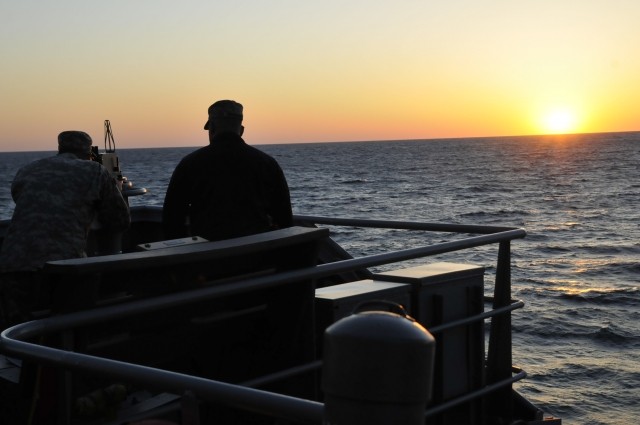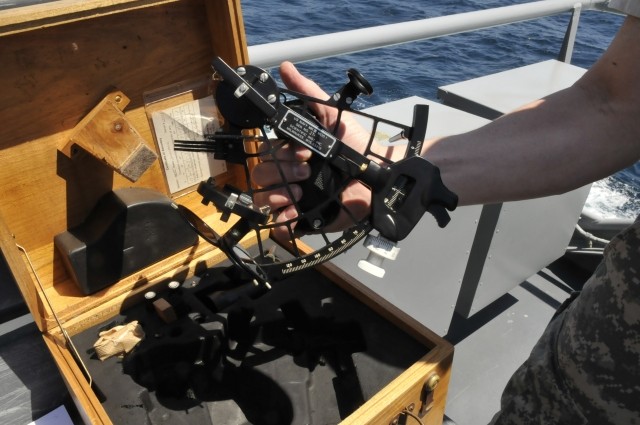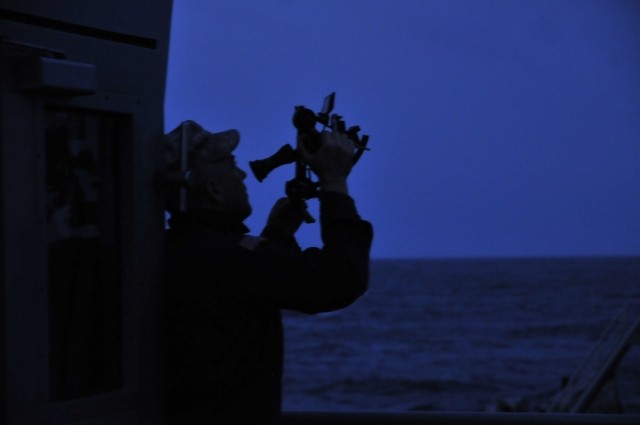AT SEA - It is 4 a.m., a Logistics Support Vessel is out in the ocean and suddenly a flash thunderstorm erupts. The boat's navigation system has just shut down. What happened' There are still two hours till day break and the navigation system is not rebooting. How does the crew get out of the storm and avoid potential danger'
During a 10-day cruise from Fort Eustis' 3rd Port to Savannah, Ga., students enrolled in the Marine Warrant Officer Basic Course, learn the basic tools to assist them if such a scenario occurs. The cruise portion of the course is called celestial navigation and the new warrant officers learn by hands on experience how to navigate the seas.
"What they use are the stars, the Moon, Sun and the planets. The purpose of the cruise is solely to navigate without electronic equipment," said retired Warrant Officer Alvin Lipson, an instructor with MWOBC.
Celestial navigation is a small part of the course which encompasses what marine warrants are expected to know. The course is 33 weeks long. Some of the tasks they learn are basic piloting, electronic navigation, tug and towing, ship handling and of course celestial navigation. Many of those courses are approved by the Coast Guard, according to Lipson. For those reasons, Lispon believes this course is one of the longest and hardest courses in the Army.
There are certain tools that are needed to navigate the stars. One is a sextant. An instrument developed in the 18th century, it was an advancement to the previous octant. The octant made visible the angles from the boat to celestial bodies that can be calculated, and then translated to a latitude or longitudinal line. The sextant's longer range of visibility separation combined with its durability made it a favorite. Now Global Positional Systems and other electronic equipment displaced the old methods but not in this course, and not especially when systems malfunction. Also used with the sextant are navigation manuals, almanacs, azimuth circles, stop watches, drafting and plotting gear.
From a student's perspective, even with all the concepts and tools, the course is still difficult.
"This is the hardest course I have ever been in my career. As much as I know about navigation, going to this course showed me a whole different level," said Warrant Officer Wade Peyton, originally from Oklahoma City, Okla. "This is a perishable skill, at anytime you can lose it if you don't use it."
Warrant Officer Francis Silva, another MWOBC student adds, "The course is very math intensive; Lots of algebra and trigonometry. At times it can be challenging but once you get it, it is fun"
With such an arduous task comes a great reward.
"After this course, the officers become masters of a small boat [Landing Craft Utility or small tug] or a mate of a large boat [Logistics Support Vessel or large tug]. The license they receive after is a merchant marine license equivalent to a United States Coast Guard Ship with a gross ton weight of 220 tons. What they do in 33 weeks takes three to four years in the civilian world to accomplish."
On July 1 the course will end for these marine warrants. From then on they will be expected to take charge of their boats and help navigate through the treacherous waters the ocean can offer. The tools are there, whether it it notional or electronic, for those moments when equipment can malfunction. The formulas have been calculated, the terrain mapped, and the lessons are hoped to have been learned, for the next step for a newly crowned ship masters is accomplishing the mission.
Story and photos by Sgt. Edwin Rodriguez, 7th Sustainment Brigade Public Affairs For queries, contact 7th Sustainment Brigade Public Affairs at: (757) 878-5112 ext. 268.
For high-resolution photos and stories by the 7th Sustainment Brigade, please contact the Digital Video and Imagery Distribution System by calling (678) 421-6612 or access them online at http://www.dvidshub.net/units/7SB








Social Sharing